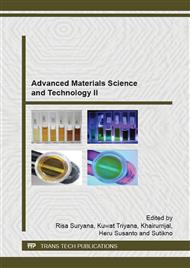[1]
T. Nagaura, K. Tozawa, Lithium ion rechargeable battery, Prog. Batteries Sol. Cells 9 (1990) 209.
Google Scholar
[2]
B. Gao, C. Bower, J.D. Lorentzen, A. Kleinhammes, X. -P. Tang, L.E. McNeil, Y. Wu, O. Zhou, Enhanced saturation lithium composition in ball-milled single-walled carbon nanotubes, Chem. Phys. Lett. 327 (2000) 69.
DOI: 10.1016/s0009-2614(00)00851-4
Google Scholar
[3]
H. Shimoda, B. Gao, X.P. Tang, A. Kleinhammes, L. Fleming, Y. Wu, O. Zhou, Lithium intercalation into opened single-wall carbon nanotubes: storage capacity and electronic properties, Phys. Rev. Lett 88 (2002) 015502-1.
DOI: 10.1103/physrevlett.88.015502
Google Scholar
[4]
Z.H. Yang, H.Q. Wu, Electrochemical intercalation of lithium into fullerene soot, Mater. Lett. 50 (2001) 108–114.
Google Scholar
[5]
G. Maurin, Ch. Bousquet, F. Henn, P. Bernier, R. Almairac, B. Simon, Electrochemical lithium intercalation into multiwall carbon nanotubes: a micro-Raman study, Solid State Ionics 136–137 (2000) 1295–1299.
DOI: 10.1016/s0167-2738(00)00599-3
Google Scholar
[6]
A. Thess, R. Lee, P. Nikolaev, H. Dai, P. Petit, J. Robert, C. Xu, Y.H. Lee, S.G. Kim, A.G. Rinzler, D.T. Colbert, G.E. Scuseria, D. Tomanek, J.E. Fischer, R.E. Smalley, Crystalline ropes of metallic carbon nanotubes, Science 273 (1996) 483–487.
DOI: 10.1126/science.273.5274.483
Google Scholar
[7]
Y. Ando, X. Zhao, H. Shimoyama, G. Sakai, K. Kaneto, Physical properties of multiwalled carbon nanotubes, Int. J. Inorg. Mater. 1 (1999) 77–82.
DOI: 10.1016/s1463-0176(99)00012-5
Google Scholar
[8]
G. Van Lier, C. Van Alsenoy, V. Van Doren, G. Geerlings, Ab initio study of the elastic properties of single-walled carbon naotubes and graphene, Chem. Phys. Lett. 326 (2000) 181–185.
DOI: 10.1016/s0009-2614(00)00764-8
Google Scholar
[9]
M.M.J. Treacy, T.W. Ebbesen, J.M. Gibson, Exceptionally high Young's modulus observed for individual carbon nanotubes, Nature 381 (1996) 678–680.
DOI: 10.1038/381678a0
Google Scholar
[10]
M.F. Yu, O. Lourie, M.J. Dyer, K. Moloni, T.F. Kelly, R.S. Ruoff, Strength and breaking mechanism of multiwalled carbon nanotubes under tensile load, Science 287 (2000) 637–640.
DOI: 10.1126/science.287.5453.637
Google Scholar
[11]
S. Yang, J. Huo, H. Song, X. Chen, Electrochim, A comparative study of electrochemical properties of two kinds of carbon nanotubes as anode materials for lithium ion batteries, Acta 53 (2008) 2238–2244.
DOI: 10.1016/j.electacta.2007.09.040
Google Scholar
[12]
C.H. Mi, G.S. Cao, X.B. Zhao, A non-GIC mechanism of lithium storage in chemical etched MWNTs, J. Electroanal. Chem. 562 (2004) 217–221.
DOI: 10.1016/j.jelechem.2003.09.004
Google Scholar
[13]
A.L.M. Reddy, M.M. Shaijumon, S.R. Gowda, P.M. Ajayan, Coaxial MnO2/Carbon Nanotube Array Electrodes for High-Performance Lithium Batteries, Nano Lett. 9 (3) (2009) 1002–1006.
DOI: 10.1021/nl803081j
Google Scholar
[14]
Y. Zhang, Z.G. Zhao, X.G. Zhang, H.L. Zhang, F. Li, C. Liu, H.M. Cheng, Pyrolytic carbon-coated silicon/Carbon Nanotube composites: promising application for Li-ion batteries, Int. J. Nanomanuf. 2 (1/2) (2008) 4–15.
DOI: 10.1504/ijnm.2008.017834
Google Scholar
[15]
J.Y. Eom, J.W. Park, H.S. Kwon, S. Rajendrana, Electrochemical Insertion of Lithium into Multiwalled Carbon Nanotube/Silicon Composites Produced by Ballmilling, J. Electrochem. Soc. 153 (9) (2006) A1678–A1684.
DOI: 10.1149/1.2213528
Google Scholar
[16]
Jabari, R Seresht., & M. Jahanshahi, Fullerenes Nanotubes Carbon Nanostruct 2 (2010) 1-12.
Google Scholar
[17]
Biró, L., Horváth, Z., Szalmás, L., Kertész, K., Wéber, F., Juhász, G., Radnóczi, G., & Gyulai, Continuous carbon nanotube production in underwater AC electric arc, J. Chemical Physics Letters 372 (2003) 399-402.
DOI: 10.1016/s0009-2614(03)00417-2
Google Scholar
[18]
T. E. Saraswati, T. Matsuda, A. Ogino, M. Nagatsu, Surface modification of graphite encapsulated iron nanoparticles by plasma processing, Diam. Relat. Mater. 20 (2011) 359-363.
DOI: 10.1016/j.diamond.2011.01.027
Google Scholar
[19]
A. Goel, J. B. Howard, J. B. Vander Sande, Size analysis of single fullerene molecules by electron microscopy, Carbon 42 (2004) 1907–(1915).
DOI: 10.1016/j.carbon.2004.03.022
Google Scholar
[20]
S. J. Yeo, R. Pode and J. S. Ahn, Study on the Size of Fullerene (C$_{60}$)Aggregates in Solution by Photoluminescence and HRTEMMeasurements, J. Korean Phys. Soc. 55 (2009) 322-326.
DOI: 10.3938/jkps.55.322
Google Scholar


